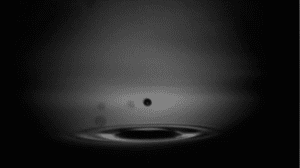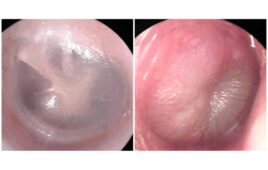
A picture (slowed 2500x) showing tests of the acoustic ejection technique that will be used in the printer. The researchers can eject these droplets from an open surface, which avoids contamination and clogging, problems that are common to bioprinting. [Image from Stanford University]
The bioprinter consists of acoustic pulses that shoot through blood samples of a patient. The pulses push individual blood droplets onto a piece of paper. Tens of millions are printed on the final print, but the researchers suggest that there’s only a few droplets that are important and contain bacteria that has the potential to threaten the life of the patient.
The team is developing the printer and an advanced way of scanning and identifying bacteria that could speed up the diagnosis of bacterial blood infections to help reduce using ineffective antibiotics.
“This is a truly interdisciplinary project,” Jennifer Dionne, associate professor of materials science and engineering, said in a press release. “Our team’s collaboration across the schools of engineering, medicine and business has given rise to new ideas that may not have emerged in a traditional setting.”
Currently, the Stanford researchers are working on developing a prototype that they hope to make as low-cost as possible to work toward having effective, yet affordable, healthcare everywhere. They are also working on further developing the system to test other bodily fluids like saliva or urine to identify other biological indicators of disease.
The current method for screening bacterial infections to determine the proper antibiotic to treat with involved growing blood-born bacteria in the lab. The researches say that method may take too long in some cases.
“Patients with bacterial infections in their bloodstream may develop sepsis. If left unchecked, sepsis can progress to multi-organ failure fairly quickly, and unfortunately, some septic patients will die,” said Stefanie Jeffrey, a professor in the department of surgery. “So, they are treated with a combination of strong antibiotics that cover a large spectrum of bacteria, hoping that these antibiotics will treat the particular bacteria that may be causing the infection.”
Antibiotics are used to fight infection, but sometimes they can have toxic side effect. They can also increase the chances of bacteria becoming resistant to the antibiotic.
The research team is working on designing the printer to be faster than growing cells in a lab. The print out is able to be scanned using a laser. The light colors that bounce off the page will reveal the cell types that are present in the blood droplets. Then, machine learning algorithms will analyze the light to determine the presence of a specific type of bacteria and whether antibiotics will respond positively or not. The whole process only takes a few minutes.
Once the team is finished building the printer, the researchers hope the process will be automated at point-of-care to reduce the workload of healthcare professionals.
“Because of Stanford expertise in so many areas – nanoparticles, optics, droplets, acoustic printing, artificial intelligence and infectious disease – we can build on advanced technology and hopefully make it cost-effective,” said Jeffrey. “We’re very fortunate that we’re able to bring together a collaborative team that covers many different areas to work toward one goal.”
In tests, the researchers tested the printer’s algorithm on 31 different strains of bacteria that were grown in a lab. The bacteria represented 95% of bacterial infections that were typically present at Stanford Hospital. The algorithm was able to recommend correct treatment with over 98% accuracy. It also showed over 80% accuracy with diagnosing bacterial infections from just a single cell in the patient sample. It had over 90% accuracy with 10 bacterial cells present.
The researchers are now working on enhancing the algorithm’s detection to make the signals brighter. To do this, they are working with metallic nanostructures that improve the signal that is absorbed and produced by laser lights that come into contact with the cells. One of the challenges they are currently working on is testing whether results from pure bacteria sales will be able to hold up if analyzed in whole blood. Proteins and other cellular and extracellular components might interfere with the signal.
“The nanoparticles efficiently absorb and scatter light,” said postdoctoral scholar Amr Saleh. “The Rose Windows in Stanford Memorial Church get their color from a similar process.”




